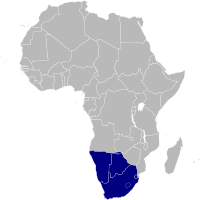
Photo from wikipedia
Population substructure within human populations is globally evident and a well-known confounding factor in many genetic studies. In contrast, admixture mapping exploits population stratification to detect genotype–phenotype correlations in admixed… Click to show full abstract
Population substructure within human populations is globally evident and a well-known confounding factor in many genetic studies. In contrast, admixture mapping exploits population stratification to detect genotype–phenotype correlations in admixed populations. Southern Africa has untapped potential for disease mapping of ancestry-specific disease risk alleles due to the distinct genetic diversity in its populations compared to other populations worldwide. This diversity contributes to a number of phenotypes, including ancestry-specific disease risk and response to pathogens. Although the 1000 Genomes Project significantly improved our understanding of genetic variation globally, southern African populations are still severely underrepresented in biomedical and human genetic studies due to insufficient large-scale publicly available data. In addition to a lack of genetic data in public repositories, existing software, algorithms and resources used for imputation and phasing of genotypic data (amongst others) are largely ineffective for populations with a complex genetic architecture such as that seen in southern Africa. This review article, therefore, aims to summarise the current limitations of conducting genetic studies on populations with a complex genetic architecture to identify potential areas for further research and development.
Journal Title: Molecular Genetics and Genomics
Year Published: 2020
Link to full text (if available)
Share on Social Media: Sign Up to like & get
recommendations!